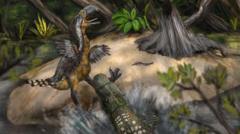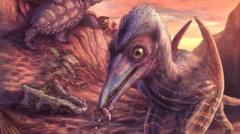In an intriguing revelation from the Tatacoa Desert in Colombia, researchers have uncovered evidence indicating that a gigantic terror bird met its demise at the jaws of a formidable caiman around 13 million years ago. These findings, detailed in a recent study published in the journal Biology Letters, highlight the fierce competition and interactions between top predators of the ancient ecosystem.
The terror bird, an apex predator of its time, would have towered over an average human, boasting powerful legs and a sharp, hooked beak designed for hunting. However, the leg bone fossil studied by the team bore distinctive teeth marks that scientists matched to those of a caiman—a crocodile-like reptile that might have been over five meters in length.
Lead researcher Andres Link from the Universidad de Los Andes in Bogotá explained that the leg bone had no signs of healing from the bite marks, suggesting the bird likely died from the attack. This assessment implies a dramatic story of survival and conflict between these ancient predators, raising questions about the vulnerabilities of even the most fearsome creatures.
The leg bone was first unearthed more than 15 years ago by local fossil enthusiast César Augusto Perdomo, who has amassed an impressive collection of fossils from the region. Working in tandem with Perdomo, the researchers were able to analyze the fossil and its markings to comprehend the ferocious nature of life during that epoch.
The scene of the conflict was a humid swamp during the Middle Miocene, where the environment allowed for the preservation of bones that have remained intact for millions of years. The new findings provide a rare glimpse into the behavior of these predators and broaden our understanding of prehistoric ecosystems.
Dr. Link emphasized the importance of each fossil in piecing together the history of life on Earth, demonstrating how even a small bone can unlock the secrets of an ancient world filled with fierce battles and survival. As scientists continue to study these remarkable discoveries, they unveil the dynamic relationships that have existed between different species long before humanity walked the planet.


















